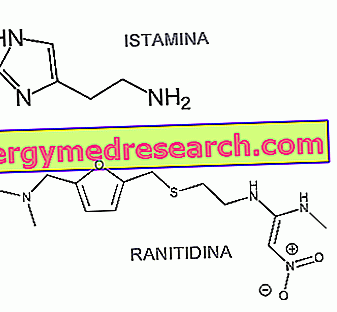
Histamine H2 receptor antagonists
Therapeutic use
H 2 histamine receptor antagonists, more commonly called H 2 antagonists, are one of the most widely used classes of drugs in the treatment of gastritis, in the prevention and treatment of duodenal ulcer and in certain particular conditions, such as Zollinger's syndrome -Ellison, characterized by an excessive production of hydrochloric acid in the stomach. Non-prescription specialties (SOPs) containing H 2 antagonists are used in the treatment and prevention of heartburn and acid indigestion.
Chemical Structure and Action
The chemical structure of the H 2 histamine receptor antagonists is similar to that of histamine, but the most important difference is that instead of the ethylamine group of the histamine, the H 2 antagonists have a voluminous side chain that allows them to inhibit in a competitive histamine access to H 2 histamine receptors: consequently, a lowering of the secretion of hydrochloric acid in the stomach is obtained.

H 2 histamine receptor antagonists are very selective molecules for H 2 histamine receptors and have no significant effect on H 1 histamine receptors; these molecules, thanks to their pharmacokinetic profile and their properties, do not even act on the H 2 histamine receptors that are located outside the gastric wall, such as those of blood vessels or smooth muscles. The hydrophilic character of the H 2 antagonists causes these molecules to be able to pass the blood-brain barrier only in irrelevant quantities; consequently, there is the advantage of the lack of important effects on the central nervous system.
- Ranitidine
- Cimetidine
- Famotidine
Ranitidine
Ranitidine is certainly the most used and famous molecule belonging to the H 2 histamine receptor antagonist class.
This molecule was developed in the 1970s by the pharmaceutical company Glaxo to face the competition of another company, then known as Smith Kline & French; it is worth mentioning that ranitidine was the result of careful planning and rational drug design.
Ranitidine inhibits the secretion of hydrochloric acid in the stomach - which increases after various secretological stimuli such as food and caffeine intake or increased insulin levels - by acting on the H 2 histamine receptors of gastric parietal cells and blocking thus the access of histamine to receptors. In this way there is the direct reduction of the total volume of secreted gastric juice and indirectly there is the reduction of the secretion of pepsin, the amount of which depends on the volume of the gastric juice. The ability to reduce the concentration of hydrogen ions in gastric juice means that ranitidine has an important protective action on the gastric mucosa against the irritating and damaging effect of NSAIDs. The intake of ranitidine does not appear to modify gastric filling and motility, nor the biliary and pancreatic secretion. Thanks to several studies, it was confirmed that ranitidine does not affect the release of hormones stimulated by histamine; this is because its hydrophilic nature does not allow it to cross the blood-brain barrier in significant quantities.
Ranitidine is found on the market under the name of various registered specialties, among which we mention: Zantac ®, Ranidil ® and Ranibloc ®, while the name of the generic drug is the same as the active ingredient, ie ranitidine.
Posology and Mode of Use
After oral administration, ranitidine is quickly absorbed in the gastrointestinal tract; in this regard, the presence of food in the stomach does not alter the degree of absorption but increases the onset time of the plasma peak.
In the treatment of gastric ulcer and peptic ulcer the attack dose is 300 mg of ranitidine per day, divided into two administrations or concentrated in a single administration before sleeping. It is advised to take the drug on a full stomach to reduce the appearance of gastric irritation; alternatively, the drug can be taken along with water or milk. In cases where maintenance treatment is required, 150 mg / day of ranitidine is used, taken in a single administration before sleeping. In general, it is advisable to take the drug on a full stomach or alternatively with liquids such as water and milk.
In the treatment of peptic ulcer in children, from 4 to 8 mg / kg of ranitidine per day can be used, divided into two administrations; in any case, the maximum dose of 300 mg / day should not be exceeded.
Ranitidine is also used in the eradication treatment of Helicobacter pylori, at a dose of 300 mg / day, divided into two doses together with 2250 mg / day of amoxicillin and 1500 mg / day of metronidazole. However it is not advisable to extend the treatment beyond two weeks.
In gastroesophageal reflux disease the dose used is 300 mg / day of ranitidine, divided into two administrations or concentrated in a single administration before going to sleep; the recommended treatment duration is 8 to 12 weeks. In the most serious cases, depending on the need, up to 600 mg / day of ranitidine can be taken, divided into four administrations. In children, 2 to 4 mg / kg are used every 8 hours. In all cases it is recommended to administer the drug on a full stomach to reduce the possibility of gastric irritation. However, the H 2 antagonists, in the treatment of gastroesophageal reflux disease, are considered second choice drugs compared to proton pump inhibitors and in any case reserved for mild and / or moderate cases.
In the treatment of Zollinger-Ellison syndrome, the dose used is 450 mg / day of ranitidine, divided into 3 daily administrations, always on a full stomach to avoid the appearance of gastric irritation. In the most serious cases, up to 900 mg / day can be administered divided into several administrations.
In the case of operations requiring the aspiration of gastric juice, 150 mg of ranitidine are administered the evening before the operation, followed by another 150 mg administered two hours before the induction of anesthesia.
Contraindications and Warnings
Before starting any treatment with ranitidine it is necessary to ensure the absence of a possible gastric carcinoma, since ranitidine - relieving and covering its symptoms - makes the correct diagnosis of the neoplasm much more difficult. Ranitidine is a drug that undergoes the first hepatic passage, therefore in cases of hepatic failure the drug should be administered with caution to avoid a possible accumulation of ranitidine in the body; on the other hand, when dealing with severe kidney failure, it is recommended to administer ranitidine in smaller doses or at longer intervals than normal therapy. When ranitidine is administered in combination with antacids, the range of use of the two drugs should be at least two hours, because antacids containing aluminum hydroxide and magnesium hydroxide slow the absorption of ranitidine by about 25%. Particular attention should be paid to cases of concomitant administration of ranitidine - in doses greater than 400 mg / day - and oral anticoagulants, because the effect of anticoagulants appears to increase. As much attention must be paid to the administration of ranitidine together with nifedipine, because the pharmacological effect of the latter active ingredient may be increased; in this regard, in the case of joint administration of the two drugs, it is recommended to perform periodic control tests on myocardial activity. An interesting case is that of the administration of morphine together with ranitidine; from several clinical cases it has been shown that the simultaneous intake of these two drugs can lead to mental confusion.
Pregnancy and breastfeeding
Although used for a long time, unfortunately there are no studies on H 2 antagonists used in pregnant women. However, from animal studies it appears that ranitidine does not cause any defect or problem in the normal development of pregnancy. However, before starting ranitidine therapy or the various specialties without a prescription, it is advisable to consult your doctor. Ranitidine has been proven to be secreted into breast milk and several studies have confirmed that ranitidine has the same pharmacokinetic profile in both adult and pediatric patients over six months of age; only in newborns (younger than one month) is there an increase in half-life and a decrease in plasma clearance; the use of the drug during breastfeeding may cause side effects, such as a decrease in the amount of hydrochloric acid in the baby's stomach; therefore, the mother may be forced to take another drug or to stop breast-feeding during ranitidine therapy. To avoid this, it is advisable to discuss with your doctor the benefits and risks of ranitidine treatment during breastfeeding and pregnancy.
Side and unwanted effects
Generally, ranitidine is well tolerated by the body. The most frequent side effects are gastrointestinal, which include constipation, nausea, vomiting, diarrhea and abdominal pain. It has been confirmed that discontinuation of ranitidine therapy leads to a return of acid hypersecretion. Other quite frequent side effects are the central ones, which include headache, insomnia, drowsiness and dizziness; much more rarely, especially in elderly patients, agitation, hostility and disorientation can occur. Hepatic side effects during ranitidine treatment include a slight increase in transaminases in the bloodstream. However, cases of serious hepatotoxicity during the use of ranitidine are rare. In the case of intravenous or parenteral ranitidine administration slight bradycardia may occur.



